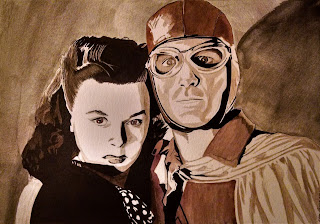LEGENDARY HEROES #39
SPY SMASHER
When Fawcett Publications decided to enter the comic book field they turned to Bill Parker and C. C. Beck to create characters for them. Parker wrote the stories and Beck illustrated them, and Spy Smasher was one of several heroes that they came up with. Spy Smasher would become one of Fawcett's most popular characters and he was introduced in Whiz Comics #2 (February 1940) alongside another Parker & Beck creation called Captain Marvel. In that introductory story readers met Alan Armstrong, a wealthy Virginia sportsman who is an intelligent scientist and inventor, a master detective, and a skilled hand-to-hand combatant. Alan Armstrong is engaged to Eve Corby whose father is an Admiral in Naval Intelligence. One day Admiral Corby confides to his future son-in-law that he suspects that a string of recent "accidents" at the navy yards are actually the work of saboteurs. Armstrong decides to look into the matter himself. He dons an aviators outfit with goggles to conceal his face, a red cape, and a diamond emblem on his chest to become Spy Smasher. Equipped with a number of gadgets of his own invention, including a specialized vehicle called the Gyrosub (part airplane, part automobile, and part submarine) Spy Smasher goes after the deadly spy ring and it's Nazi leader The Mask. Spy Smasher was given his own title in the Fall of 1941 while he continued to appear in Whiz Comics. The Spy Smasher title ran for 11 issues until February 1943, and in 1942 his costume was changed to green from the original khaki brown.
Two weeks after Pearl Harbor production began at Republic Pictures on a 12-chapter serial of Spy Smasher. Kane Richmond was cast as Spy Smasher, Marguerite Chapman as Eve Corby, Sam Flint as Admiral Corby, and Hans Schumm as the evil spy The Mask. With America's entry into the war patriotism was at an all-time high, and "Spy Smasher" became one of the studio's best efforts. At a cost of $156,431 the serial was the most expensive Republic feature of 1942. The multi-chapter film was shot from December 22, 1941 until January 29, 1942 and is universally heralded as one of the best serials ever made...maybe even THE best! Compared to most serials "Spy Smasher" had great dialogue and above average cinematography. But mostly what it had were spectacular stunts and special effects. The serials were also known as "cliffhangers" back in the day and "Spy Smasher" was pure entertainment from start to finish. Much of the thrilling stunts in the movie could be attributed to three of the best stuntmen in the business. There was Yakima Canutt, a champion rodeo rider who doubled for John Wayne in "Stagecoach" (1938). Canutt supervised the chariot race in "Ben Hur" (1959) which involved 9 teams of four horses, and not a single horse was injured in the making of the film. There was Carey Loftin, one of the most accomplished stunt drivers in Hollywood. Any car chase in "Spy Smasher" featured Loftin who would later drive the green Mustang in the movie "Bullitt". And lastly there was Dave Sharpe, one of the greatest stuntmen ever and a tumbling champion, Sharpe appeared in 5000 movies over six decades. And that's not a typo. FIVE THOUSAND MOVIES! He became the stunt double of Tony Curtis and it was said around Hollywood that when you hired Tony Curtis you also got Dave Sharpe. When Sharpe died, Tony Cutis eulogized him at his funeral.
So what made "Spy Smasher", the serial so innovative? In one scene Dave Sharpe, as Spy Smasher, rolls from an overturning motorcycle to leap atop a careening car plunging from a cliff. And that's just one example. Throughout WWII Spy Smasher was a popular character in the comic books, but with the end of the war Spy Smasher was left without a battle to fight. Crime comics were gaining in popularity and Fawcett decided to change the character's name to Crime Smasher in Whiz Comics #76 (July 1946). But the name change didn't help and Crime Smasher fell out of favor with the public. His last appearance in Whiz Comics was #83 in March 1947, and one issue of Crime Smasher in 1948. And then he disappeared. Spy Smasher, the triumphant hero over Nazi spies and saboteurs, finally met his match in public apathy.


.jpg)

.jpg)
Comments
Post a Comment